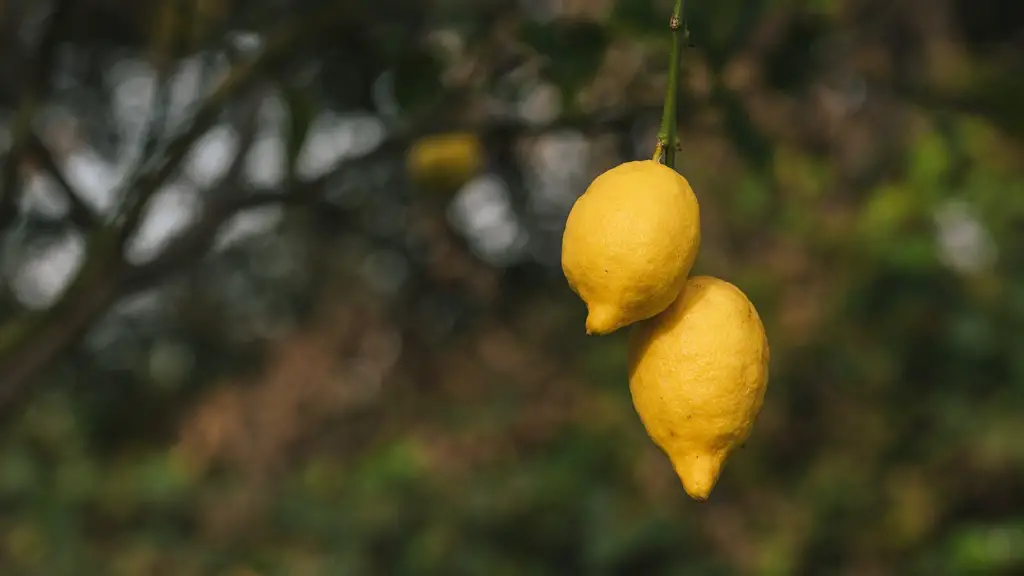Pruning is a very important step in keeping your lemon tree healthy and under control. By removing unhealthy or dead branches, you allow the tree to direct its energy towards new growth. In addition, pruning also helps to promote fruiting by encouraging the formation of flower buds. When pruning your lemon tree, be sure to use sharp, clean pruning shears. Make cuts at a 45 degree angle, just above a leaf node (where the leaf attaches to the branch).
To prune an indoor lemon tree, first cut away any dead or diseased wood with sharp, clean pruning shears. Next, trim away any branches that are rubbing against each other or that are growing inwards towards the center of the tree. Finally, cut back any branches that are longer than about 1/3 of the overall height of the tree.
How do you prune a potted lemon tree?
As this plant grows and matures, the top will get very full. To keep the plant from getting too top-heavy, create two or three more leads.
The best time to root prune or repot your indoor lemon tree is early spring through to mid-summer. This is when the tree is actively growing and will be able to recover quickly from any disturbance. Root pruning will encourage the tree to produce new roots, which will help to anchor it in the new pot. Repotting will also give the tree a chance to start fresh with new potting mix and a new pot that is the right size for its current growth.
Should I prune my potted Meyer lemon tree
Pruning your Meyer Lemon Tree is a great way to keep it healthy and happy! When you prune, be sure to look for branches that are growing straight upwards, as this will help keep the tree wide and branched out. This will also promote fruit production.
Deciduous fruiting trees need to be pruned for a number of reasons. Pruning will improve branch set, reduce the possibility of breaking from heavy fruit, increase aeration and light availability, and improve the overall quality of the fruit. Lemon trees, in particular, will benefit from pruning in order to produce healthier fruit.
What is the best way to care for an indoor lemon tree?
When potting an indoor lemon tree, always leave a few inches at the top of the pot for watering. Indoor lemon trees do best when their soil stays evenly moist, so choose a well-draining potting mix designed for indoor palm trees or citrus. These mixes help prevent soggy soil while still retaining moisture, so roots don’t get too wet or too dry.
Lemon trees are a popular choice for both indoor and outdoor planting, and they can live for a long time with proper care. Lemon trees usually live for 30-50 years, but indoor potted trees tend to have shorter lifespans than trees planted in the ground outdoors. Lemon trees can grow to over 100 years old in good conditions, making them a great investment for the future.
How often do indoor lemon trees produce fruit?
Few citrus plants are as easy to grow indoors as Meyer lemon trees. They provide sweet scented blooms and fruit up to 4 times per year. Because they require no chill hours to fruit, Meyer lemon plants can be grown indoors year-round.
Lemons are a type of citrus fruit that is easy to grow indoors. They make great gifts and provide beautiful, fragrant flowers. All you need to do is provide the light, water, and fertilizer.
How do you take care of a lemon tree indoors in the winter
In winter, it’s important to lower the room temperature for your citrus trees. They’ll go semi-dormant and do best with a room temperature of 58-68 degrees. Consider supplemental lighting to help them adjust, and rotate the plant regularly. Fertilize monthly and improve air circulation. Water properly and watch for pests.
Per the Miracle-Gro Water Soluble All Purpose Plant Food label, it can be used on all trees and shrubs. This product is ideal for use on newly planted trees and shrubs, as well as established trees and shrubs. This product will give your trees and shrubs the extra nutrients they need to grow and thrive.
How do I make my lemon tree bushy?
Assuming you want tips on how to choose a Christmas tree:
When picking out a Christmas tree, you first need to decide how tall you want it to be. Once you have that measurement, you can start narrowing down your choices.
Next, you’ll want to take into account the type of tree you want. If you’re looking for a traditional evergreen, there are many different varieties to choose from. If you want something a little different, you could also go for a artificial tree or a potted tree that can be used year after year.
Once you’ve decided on the height and type of tree, you can start looking at other factors, such as the color of the needles, the shape of the tree, and whether or not you want it to be pre-lit.
Keep all of these factors in mind when choosing your tree, and you’re sure to end up with one that you love!
Lemon trees are happy in containers, provided they have enough root room and good drainage. We recommend ‘Improved Meyer’ (USDA Zones 9–11) as one of the best varieties to grow in a pot, because it is naturally dwarfed. It will mature to just 3 to 5 feet.
Can I shape my lemon tree
Pruning citrus trees helps to promote new growth and manage the fruiting surface area. It is important to prune trees early in the season for the best results.
If you have an indoor lemon tree, make sure to mist it daily, especially during cooler months when you’re running your heat. Citrus leaves love humidity and your tree will do best if it’s kept moist.
How do you shape a lemon tree?
Good pruning practices will ensure that your trees get the air and sunlight they need to stay healthy.random branches can block out sunlight and airflow, so it’s important to remove them. This will also help your trees to direct their energy into producing new growth.
Citrus trees do not go dormant like many other plants, so they need sufficient light and some humidity during the winter (although their growth will slow during this time). Citrus trees need to be protected from the cold weather, so make sure to bring them indoors or into a greenhouse if the temperature outside gets too low. Keep the trees in a bright location and mist the leaves occasionally to maintain some humidity.
How do I keep my lemon tree happy
Location is important for citrus trees because they need direct sunlight for at least six hours a day. Citrus trees will not produce as much fruit if they do not have enough sunlight. Trees located in shady areas are more likely to have fungal diseases and pests.
If you’re looking to grow a lemon tree, the optimal place would be in a south-facing window. Without enough light, the plant will not produce flowers, and therefore will not produce fruit. If you’re worried about your light situation, try supplementing with a grow light. This will give your lemon tree the light it needs to produce flowers and fruit.
Conclusion
To prune an indoor lemon tree, start by removing any dead or dying branches. Next, trim away any branches that are crossing or rubbing against each other. Then, cut back any branches that are longer than the others. Finally, cut away any branches that are growing in an undesirable direction.
Pruning your indoor lemon tree will ensure that it remains healthy and vibrant. It is important to remove any dead or dying leaves, branches, and fruit. Doing this will encourage new growth and help your tree to produce more lemons.





